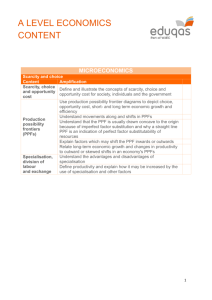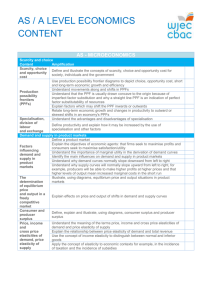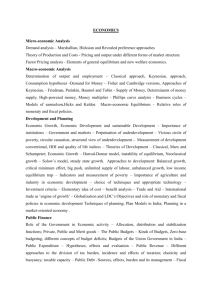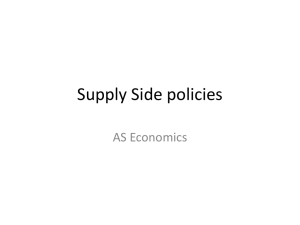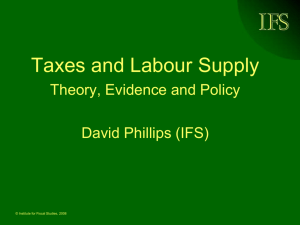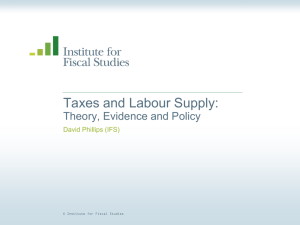AS Content Checklist Word Document
advertisement
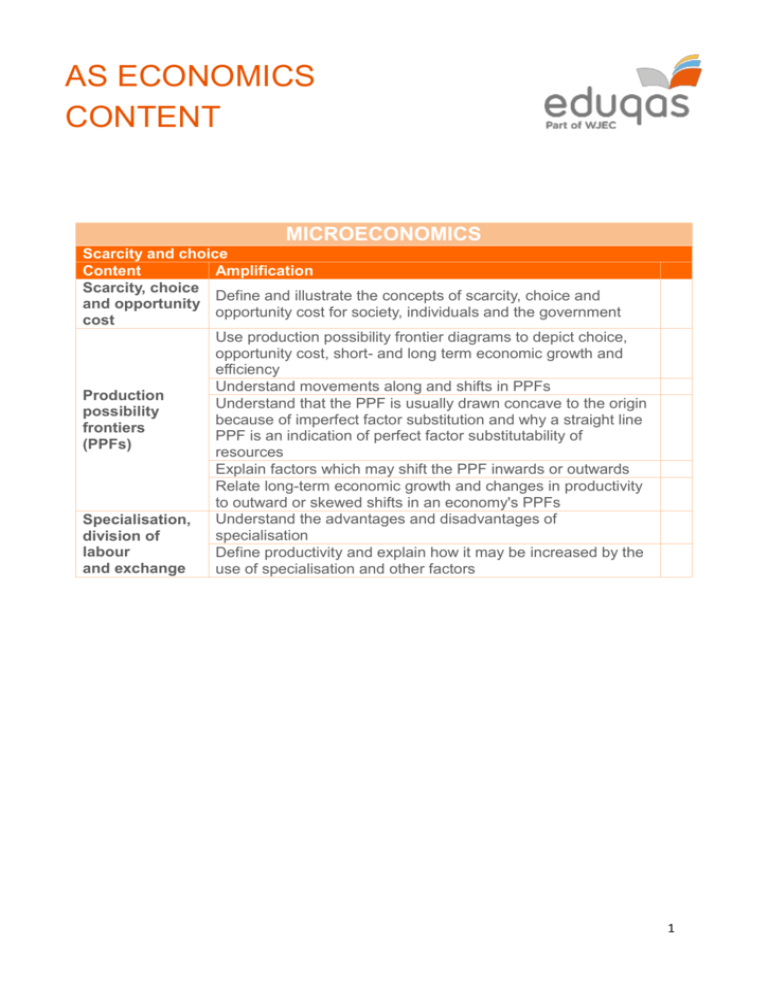
AS ECONOMICS CONTENT MICROECONOMICS Scarcity and choice Content Amplification Scarcity, choice Define and illustrate the concepts of scarcity, choice and and opportunity opportunity cost for society, individuals and the government cost Use production possibility frontier diagrams to depict choice, opportunity cost, short- and long term economic growth and efficiency Understand movements along and shifts in PPFs Production Understand that the PPF is usually drawn concave to the origin possibility because of imperfect factor substitution and why a straight line frontiers PPF is an indication of perfect factor substitutability of (PPFs) resources Explain factors which may shift the PPF inwards or outwards Relate long-term economic growth and changes in productivity to outward or skewed shifts in an economy's PPFs Understand the advantages and disadvantages of Specialisation, specialisation division of labour Define productivity and explain how it may be increased by the and exchange use of specialisation and other factors 1 Demand and supply in product markets Content Amplification Define a product market Explain the objectives of economic agents: that firms seek to maximise profits and consumers seek to maximise satisfaction/utility Understand the importance of marginal utility in the derivation of Factors demand curves influencing demand and Identify the main influences on demand and supply in product supply in markets product Understand why demand curves normally slope downward from markets left to right Understand why supply curves will normally slope upward from left to right, for example, producers will be able to make higher profits at higher prices and that higher levels of output mean increased marginal costs in the short run The Illustrate, using diagrams, equilibrium price and output determination situations in product markets of equilibrium price and output in a Explain effects on price and output of shifts in demand and freely supply curves competitive market Consumer and Define, explain and illustrate, using diagrams, consumer producer surplus and producer surplus surplus Understand the meaning of the terms price, income and cross price elasticities of demand and price elasticity of supply Price, income Explain the relationship between price elasticity of demand and and total revenue cross price elasticities of Use the concept of income elasticity to distinguish between demand, price normal and inferior goods elasticity of Apply the concept of elasticity to economic contexts for supply example, in the incidence of taxation and the incidence of subsidies 2 Demand and supply in labour markets Content Amplification Identify the main influences on demand and supply in labour markets Wage Understand determinants of the elasticity of the demand and determination supply of labour Understand the causes and implications of wage differentials Understand the factors which affect flexibility in labour markets, for example, trade union power, regulation, welfare payments and income tax rates Labour market issues Evaluate the effects of the statutory national minimum wage on labour markets Explain the impact of migration on labour markets Resource Allocation How resources Understand the role of profit and the function of prices in are allocating resources to different uses allocated in a Understand that changes in one market affect other free markets, for example, interrelationships between factor and market product markets economy Market failure Define market failure and have an understanding of efficiency, that is, the maximisation of consumer / producer surplus at the free market equilibrium output Understand that market failure may take many forms, including public goods merit and demerit goods Understanding externalities market failure monopoly power information asymmetries and gaps an absence of private property rights income inequality volatile prices Appreciate the reasons for, and the consequences of, each source of market failure for economic agents Explain why and how governments intervene in markets, for Why and how example, to correct market failure and reduce income governments inequality intervene in markets Evaluate government intervention policies Explain that, in certain cases, government intervention can create distortions in markets, for example, in agriculture, The effects of housing and labour markets government intervention Understand the reasons for government failure and be able to evaluate its effects 3 MACROECONOMICS Macroeconomic theory Content Amplification Explain the flows in the circular flow model and understand that they should be equal (income = output = expenditure) The circular Explain injections into and withdrawals from the circular flow flow of Use the model to explain the concept of national income income equilibrium and to explain how changes in injections and model withdrawals might lead to changes in the equilibrium level of national income, and hence explain the multiplier process Define the components of aggregate demand: consumption, The components investment, government spending and net export (exports minus of aggregate imports) demand Explain the factors which affect the levels of consumption and (AD) investment in the economy Understand why an AD function will slope downward from left to right The AD function Understand that changes in the components of AD can cause the function to shift The Understand the shape of the Keynesian long run aggregate aggregate supply (LRAS) curve supply (AS) Understand the factors which might result in a shift in LRAS function Illustrate and explain how AD and AS interact to determine the AD/AS equilibrium level of output, employment and prices in the long analysis run Macroeconomics objectives Government Explain the main macroeconomic objectives and possible policy conflicts between policy objectives objectives 4 Policy instruments Content Amplification Fiscal policy Framework Demand side fiscal policy Supply side fiscal policy Understand the overall purpose and structure of the budget Analyse the possible impact of changes in tax and spending on the economy using AD/AS diagrams and the Laffer curve Explain how Keynesian economists believe that fiscal policy can and should be used to control the level of aggregate demand in the economy under certain circumstances Explain that fiscal policy can be used to achieve policy objectives by operating on the supply side in the longer term (examples might include influencing incentives to work and to invest, improving infrastructure) Monetary policy Framework The operation of monetary policy and monetary stability Understand the role of the Bank of England in creating monetary and financial stability, and its status as lender of the last resort Understand the purpose of the Bank’s inflation target, its symmetrical nature and any other objectives that the Bank may be required to pursue Interest rates Understand how changes in interest rates may be used to achieve the Bank’s objectives and the factors the Bank is likely to take into account when setting base interest rates Understand how interest rate changes can impact both the real economy and inflation Discuss the extent to which changes in interest rates are likely to affect the exchange rate 5 Content Exchange rates and exchange rate policy Amplification Exchange rates in a free market Explain that in a free-float system, the exchange rate will be determined by the forces of demand and supply Use demand and supply diagrams to analyse and evaluate the factors which might cause exchange rates to appreciate or depreciate Evaluate the possible impacts of changes in exchange rates on the policy objectives Evaluate the microeconomic effects of exchange rate changes on households and firms Understand how monetary authorities can influence the value of an exchange rate in a floating system (a ‘managed’ or ‘dirty’ Exchange rate float) policy Evaluate the advantages and disadvantages of policies which hold exchange rates artificially above or below their free market levels Understand what is meant by supply side policies and Supply side understand how they can be used to try to increase trend policies growth/LRAS in the economy as well as the flexibility of product and factor markets International trade Content Amplification Evaluate the benefits and costs of free trade Free trade and Describe the main forms of protection; tariffs, quotas and other barriers protectionism Evaluate the benefits and costs of protectionism 6

